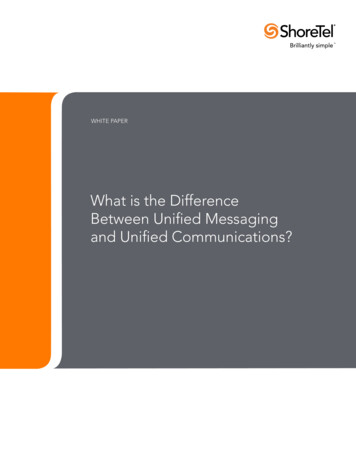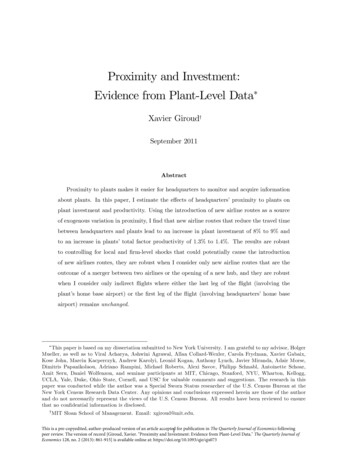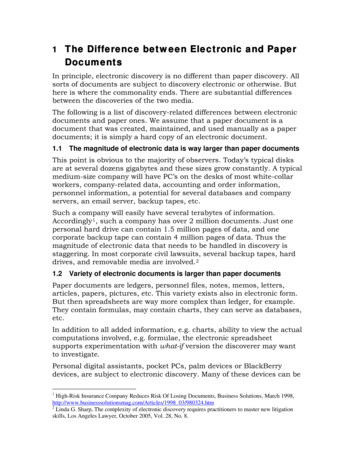
Transcription
WHITE PAPERWhat is the DifferenceBetween Unified Messagingand Unified Communications?What is the Difference Between Unified Messaging and Unified Communications?PAGE 1
Table of Contents1. Introduction . 32. What Are the Main Differences Between UM and UC? . 33. Where Did the Misconceptions About UM and UC Come From? . 54. Case Studies . 65. Conclusion . 7What is the Difference Between Unified Messaging and Unified Communications?PAGE 2
1. IntroductionOffering the dictionary definition of a term is usually an easy way to start a speech orreport. However, when the subject is unified messaging and unified communication,defining key terms is not a simple matter of flipping open the latest edition of MerriamWebster. There’s significant confusion about what unified messaging (UM) and unifiedcommunication (UC) are, and this confusion can lead organizations to make muddledor even misguided choices that compromise the effectiveness of their communicationssystem.Unified messaging (UM) allows enterprise employees to communicate quickly andeffectively. The solution integrates various communication channels, such as email,voicemail and text, into a single interface, making it easy for coworkers to connectand maintain contact. Non-unified solutions deliver these messages in separatecommunication channels, meaning employees have to take time to check eachsystem to retrieve voicemails, emails, etc.A major misconception,however, is that UM andUC solutions are oneand the same.Unified messaging services make employees’ workflows more efficient, resulting insignificant benefits to the enterprise. Think about the time workers could save each dayby having a system that allows them to quickly check all their messages from clients,coworkers and business executives. This time savings drives productivity and ultimatelyleads to business growth and profitability. When considering these advantages of thecommunication technology, it is easy to see why UM is a smart choice.While UM is extremely beneficial to organizations, unified communications (UC)systems, which include even more collaboration tools, are an even smarter choice forbusinesses interested in increasing productivity. Unified messaging tools integrate withan overall UC solution – that is, messaging tools are an important part of UC. A majormisconception, however, is that UM and UC solutions are one and the same. This is nottrue - UC involves tools that UM does not, including presence features that display whencoworkers are available to chat or otherwise communicate with colleagues and clients.UC also includes telephony options, allowing all employees regardless of their locationto communicate over a central IP telephone system. And data sharing features of UCenable coworkers to collaborate on important documents related to projects.Enterprises have reported benefits from both UM and UC, but companies should beaware that adopting UM may just be a step in the right direction, and that there are evenmore benefits to be gained by implementing a full UC solution.2. What are the main differences between UM and UC?Before trying to determine why misconceptions about unified messaging and unifiedcommunications exist, we must first understand what the main differences are betweenthe two types of services.What is the Difference Between Unified Messaging and Unified Communications?PAGE 3
Unified MessagingUM is the combination of non-real time services such as email, fax and voicemail.These kinds of messages can be left for an employee to retrieve at a convenienttime. The unified aspect of this service means that an employee can retrieve all thesemessages at one time over one system. A single inbox stores all these messages,which can be accessed from various devices such as desk phones or mobile devices.Unified CommunicationUC is the combination of non-real time services (like those seen in UM) as well asreal-time services such as instant messaging, telephony, web and video conferencingand presence. Many communication tools in UC go beyond those offered in UM,which is possibly the biggest differentiating factor between the two services. Themain difference can be seen in the voice-based and instant communication channelsincluded in UC. Video calling, for instance, makes it easier and faster for people toconnect with one another.Another tool that exemplifies how UC differentiates itself from UM is instantmessaging. The word “instant” says it all - this UC feature allows employees tocommunicate with each other in real time, unlike UM systems in which messages leftfor recipients are sometimes irrelevant or not actionable by the time they are retrieved.These tools are included in unified communication but not in unified messaging: IP Telephony: Phone communication that travels on the UC system overthe internet. Instant messaging: Allows coworkers to instantly communicate through textmessages, sharing information in real time. Presence: Notifies coworkers when a colleague is available. These presence toolsgo beyond the simple “green dot” and “Do Not Disturb” or “In Meeting”messages of some chat services. Video conferencing: Allows coworkers, customers and clients to communicateover the internet through video. This tool creates a more advanced connectionthan phone communication, and can help companies maintain contact withimportant partners faster and more often. It also cuts down on a company’scosts, as representatives can meet virtually over a web conference, instead ofgoing through the hassle and expense of traveling for in-person meetings. Data sharing: UC provides a central system on which coworkers store and shareinformation and documents for projects, important clients, etc. This informationcan be accessed from various locations and devices by simply getting on thecompany’s network.Overall, UC is far more advanced than UM and many businesses have chosen to adoptunified communication systems to maximize employee productivity and improveWhat is the Difference Between Unified Messaging and Unified Communications?PAGE 4
customer services. UC is easily becoming a preferred choice for a communicationsolution in the enterprise world. According to research firm IDC, businesses will spenda total of 377 billion between now and 2016 on UC services.Mobility has also affected which features are important to an effective UC solution.For example, the rise of smartphones and tablets has raised expectations regardingresponse time. Because these devices are always available, users expect responses totext messages and even email in near real-time. As a result, features such as instantmessaging to allow on-the-go communication between coworkers have becomeattractive and coveted parts of unified communication systems.By extending UC features to mobile devices, employees are able to respond to instantmessages and email in a matter of seconds as opposed to hours or whenever theymake it back into the office. More communication and higher productivity are directresults of incorporating instant messaging tools into a UC strategy.3. Where did the misconceptions about UM and UC come from?Both UC and UM include theintegration of numerous features:Voicemail, email and other messagingcome together with UM, and voice,telephony, video, text chat and datasharing all come together in UC.Unified messaging, however, has beenused as a vague, catch-all term inrecent years to describe the advancedcommunication technology availableto businesses. Given the closerelationship and between UC and UM,and the muddled way in which themedia and even enterprise stakeholderssometime refer to these systems, thetwo have inevitably been confused withone another.However, beyond this semantic blurring,the root of the problem may actuallylie in the fact that too few actuallyunderstand all that a UC solution offers.This is not to discount the usefulnessof UM, however. UM has been called a “subfield” of UC because unifiedcommunications does include messaging features, as described above. Messaging isan important part of UC, and UM features do interact and in some cases amplify thetools of unified communication.For instance, a UC system might include a feature to have voicemails translated intotext messages. A UC solution can take voicemails from a UM service and convertthose voice messages into a text form, making it easier for employees to receive theWhat is the Difference Between Unified Messaging and Unified Communications?PAGE 5
information on the go or even in the middle of a meeting, on their mobile device.Given the relationship between UM and UC, it’s natural they would experience roughlyparallel growth in terms of adoption rates, and a report from COMMfusion confirmedthis is the case. Since 2005, companies have been looking to replace their outdatedcommunication systems, specifically aging voicemail services, and this drove thegrowth of UM from a 772.3 million industry to a 1.28 billion industry in the span offive years.COMMfusion’s report provides valuable insight into the markets for UM and UC,but it also reflects the shifting definitions of the two types of solution. For example,COMMfusion refers to a hybrid “UM/UC” solution, which may lead to the belief theytwo services are the same.4. Case StudiesCity of OaklandThe California city has more than 5,000 employees working at 114 facilities, creating aneed for a solution that keeps all these dispersed workers connected. Before decidingto upgrade its communication, the city was operating with an outdated PBX systemfrom 1989 that caused numerous failures.In 2005, the city decided to switch to a unified communication service that enabledcity employees to communicate with one another quickly and effectively, regardless oftheir location or what facility they work from. The real-time features of the UC systemhave made communication more flexible, offering employees multiple options toreach each other. Telephony and instant messaging tools, as well as collaborationfeatures through data sharing, were crucial features for the city. This created efficientworkflows not possible with its previous phone system.“Everything I’ve heard is positive about it,” said Robert Glaze, the CTO for the City ofOakland. “People just love it.”Idyllwild Arts AcademyThe school has more than 70 buildings on campuses across Los Angeles and SanDiego in relatively remote areas, making reliable communication a must. The longlist of features available through the UC system the school adopted, as well as itsscalability, made communications flexible and adaptable, meeting the school’s needs.The school reported the UC features enhanced productivity and helped to streamlineall communication functions, not just messaging, so that students could stayconnected to parents and teachers, and staff could collaborate with one another overmultiple tools. The real-time tools of the system were seen as a major benefit.“Everyone has found the [UC] system easy to use because it adapts to the way wework, not the other way round,” said Idyllwild IT Director Buck Little.What is the Difference Between Unified Messaging and Unified Communications?PAGE 6
RMH GroupThe design and engineering firm needed communication tools that would enableemployees in the office to reach those working in the field, and the tools had to ensurethese communications could be accomplished in real time to respond to clients’changing needs.The company chose a UC system because it included collaboration tools like videoand web conferencing not available just with UM. Employees began using the UCtools of presence and instant messaging, and, as a result, employees are saving timeand increasing productivity.“A wide range of demographics work here,” said RMH Group IT Manager TroyKuskie. “We have young engineers just out of school who use their cellphones almostexclusively and then seasoned veterans who still use desk phones. The selectedcommunications solutions had to fit with our environment.”5. ConclusionIt’s easy to see the difference betweenunified messaging and unifiedcommunication: One offers real-timecollaboration solutions, while the otherdoes not. Both services are helpful to manycompanies, and with the growing attentionsurrounding unified services in recent years,it is also to see how confusion betweenUM and UC originated. However, it isimportant for companies to remember theyare separate services and do not both offerequal functionality.For companies looking to truly enhancetheir communication services andcollaboration efforts, they should lookto a simplified UC solution that is richwith features, including UM tools. A UCservice that is easy for both IT and employees to use will result in productivity andcollaboration gains - benefits that can be seen with a UM service alone but will bemuch more significant with the addition of real-time communication tools. What is the Difference Between Unified Messaging and Unified Communications?PAGE 7
About ShoreTelShoreTel is a provider of business communication solutions whose brilliantly simply unifiedcommunications platforms, applications and mobile UC solutions promise a new rhythm ofworkforce engagement and collaboration. With costly complexity eliminated by design fromits award winning, all-in-one IP phone system, UC and contact center solution, and its industryleading hosted business phone system, workers enjoy a freedom and self-reliance that otherproviders can’t match. Users have full control to engage and collaborate, no matter the time,place or device, for the lowest cost and demand on IT resources in the industry. ShoreTel isheadquartered in Sunnyvale, California, and has regional offices and partners worldwide. Formore information, visit shoretel.com or shoretelsky.comWORLD HEADQUARTERS960 Stewart Drive, Sunnyvale, CA 94085 USA. shoretel.com and shoretelsky.com 1 (800) 425-9385 Toll Free 1 (408) 331-3300 Tel. 1 (408) 331-3333 Fax for ShoreTel 1 (646) 230-5000 Tel. 1 (646) 230-5001 Fax for ShoreTel SkyEMEAASIA PACIFIC 800 408 33133 Freephone 44 (1628) 826300 Tel. 61 (0)2 9959 8000 Tel.Copyright 2012 ShoreTel. All rights reserved. The ShoreTel logo and ShoreTel are registered trademarks of ShoreTel, Inc. in the United States and/or other countries. All other copyrights and trademarksherein are the property of their respective owners. Specifications are subject to change without notice.What is the Difference Between Unified Messaging and Unified Communications?PAGE 8
Webster. There's significant confusion about what unified messaging (UM) and unified communication (UC) are, and this confusion can lead organizations to make muddled or even misguided choices that compromise the effectiveness of their communications system. Unified messaging (UM) allows enterprise employees to communicate quickly and .











